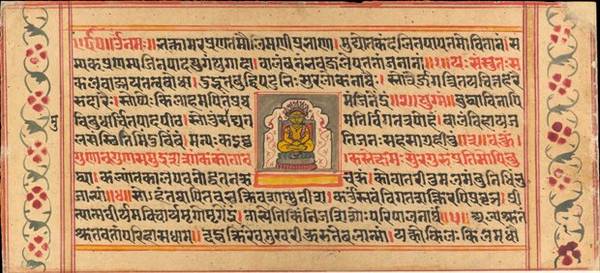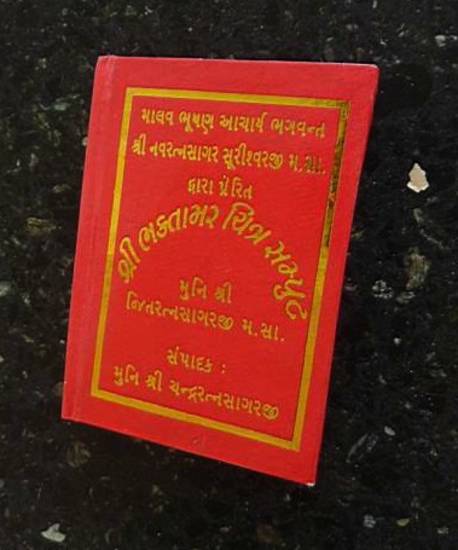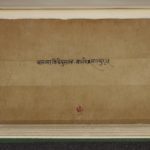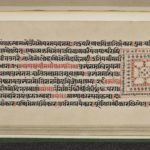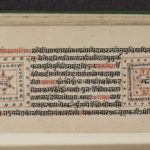Article: Bhaktāmara-stotra
One of the most popular devotional hymns of the Jains is the Bhaktāmara-stotra – Devoted Gods hymn. Both main sects of Śvetāmbaras and Digambaras accept it, counting 44 and 48 stanzas respectively. It is dedicated to the first Jina, Ṛṣabhanātha or Lord Ṛṣabha, frequently known as Ādinātha, meaning ‘First Lord’. The title comes from the first verse, which says that ‘his feet enhance the lustre of the jewels set in the crowns lowered by the devoted gods’.
Both sects claim Mānatuṅga, author of the Bhaktāmara-stotra, yet little is known about him. Recent scholarship considers that he was ‘a Śvetāmbara devotional poet who lived in the second half of the 6th century A.D.’ (Wiley 2004: 53). Mānatuṅga is the main character in several legends surrounding the hymn’s composition. Though they may vary, the stories all stress the supernatural powers created by reciting the Bhaktāmara-stotra.
The hymn is written in Sanskrit in an elaborate poetical style. The Bhaktāmara-stotra focuses on the characteristics and traits of a Jina. Most prominent are the Jina’s radiance and absolute serenity, which are features of his utter perfection.
As a favourite Jain hymn, the Bhaktāmara-stotra has generated a number of commentaries, the earliest dating from the 14th century. Many of these include the stories involving Mānatuṅga and other tales associated with the hymn, which is often given a magical value. These tales tend to emphasise the freedom from fear and life’s difficulties that reciting it brings to devotees.
Many Jain followers know the original text by heart and may daily recite or meditate upon it. The hymn is also part of the Jain tantric tradition, in which worshippers chant mantras and reflect on mystical diagrams – yantras. Unusually for a Jain hymn, the Bhaktāmara-stotra is the object of worship in a dedicated ceremony, called Bhaktāmara-pūjā. It is commonly the focus of a collective rite, a popular approach especially among Jains outside India.
Translated into many languages from the original Sanskrit, the hymn continues to be popular among contemporary Jains. Long the subject of illustrations to aid religious concentration, the Bhaktāmara-stotra has recently also been honoured in the construction of dedicated temples.
Befitting its status as a fundamental Jain hymn, the text is often recorded on manuscripts that are frequently noteworthy artefacts. JAINpedia has two digitised examples of the Bhaktāmara-stotra, held in the British Library in London, including one complete manuscript. Because of their beauty and importance in the literature and practice of the Jain faith, these items are highlights of the manuscripts on the website.
Author and legends
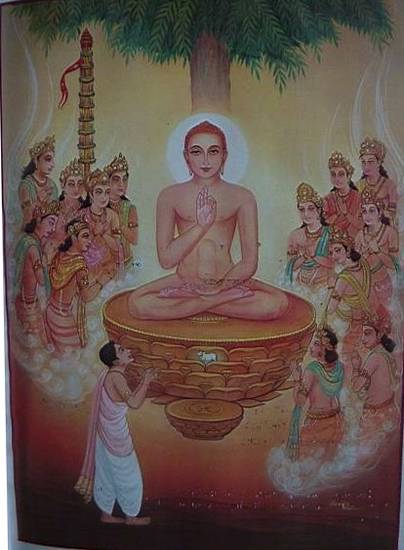
Gods composing hymns of praise
Image by Diwakar Prakashan / Padma Prakashan © Diwakar Prakashan / Padma Prakashan
The composition of the Bhaktāmara-stotra is unanimously ascribed to an author named Mānatuṅga, who was a Jain monk. The titles ācārya – ‘teacher’ – or sūri – ‘pontiff’ – may be attached to his name. But historical information about him is scarce, and his date remains a matter of hypothesis or controversy.
With both major sects claiming him as a member, Mānatuṅga and his famous composition are accorded authority among all Jains. Various tales relating to the creation of the hymn share the episode that demonstrates the power of the hymn and belief in the Jain doctrine. This features Mānatuṅga’s recitation of the Bhaktāmara-stotra freeing him from the chains that bind him.
All available sources date back to the 13th century or later. They are:
- bio-hagiographical works about important Jain teachers – prabandhas
- introductory stories in the commentaries on the hymn
- monastic lineages – paṭṭāvalīs.
Of the bio-hagiographical writings, two have accounts of Mānatuṅga:
- Prabhācandra’s Prabhāvaka-carita, completed in 1277 CE
- the 1304 Prabandha-cintāmaṇi by Merutuṅga.
All types of sources present Mānatuṅga as an ‘ancient teacher’ (Jacobi 1932: VII):
Different sources pretending to be based on tradition yield the following approximate dates of Mānatuṅga A.D. 300, 420, 630, 850, 925 or 1050
Jacobi 1932: VII
According to recent Indian scholarship (Dhaky 1997), Mānatuṅga could have lived in the 6th century CE. The earliest commentary on the hymn, however, dates back only to the 14th century. This gap is difficult to explain if the hymn were composed so early.
Ācārya Mānatuṅga is associated with Bhojpur, located 30 kilometres from Bhopal in Madhya Pradesh. The tale of the composition of the hymn always involves the poet’s release from chains. The story continues with Mānatuṅga’s staying in this locality, where he practised penance and ended his life by fasting to death. Mānatuṅga’s association with Bhojpur has led to the establishment of artefacts and memorials here, such as:
- a shrine
- an ‘emancipation-rock’ – siddha-śilā
- holy footprints – pādukās.
The neighbouring village of Ahu has the ruins of 48 pillars, which are supposed to represent the jail where Mānutuṅga was kept. Their number is the same as the number of stanzas in the Digambara hymn.
The Prabhāvaka-carita story has an interesting feature. It says that Mānatuṅga was the son of a businessman. He renounced the world and became a Digambara monk, taking the name Mahākīrti. Later on, his sister converted him to the Śvetāmbara path. Whether historical fact or not, this successive affiliation to the two principal Jain sects explains why both groups consider:
- Mānatuṅga to be theirs
- the Bhaktāmara-stotra to be authoritative and famous.
Creation of the hymn
There is no doubt that the Jain tradition regards Mānatuṅga as an important figure with great charisma. The composition of the Bhaktāmara-stotra has attracted attention in the various commentaries and profiles of Mānatuṅga. The poet gains his freedom and demonstrates the supremacy of the Jinas, especially compared with the deities of Hinduism, the majority faith in India.
According to one version of the tale behind the hymn, three poets were called to the court of King Vr̥ddhabhoja in Avanti, in central India. When they were asked to demonstrate the marvels of their poetical art:
- Bāṇa recited a hymn called the Caṇḍikā-śataka, which is dedicated to the Hindu goddess Caṇḍikā, ‘the Terrible’
- Mayūra, also a Hindu, recited the Mayūra-śataka
- Mānatuṅga asked to be put in chains, then started to recite the Bhaktāmara-stotra, whereupon the chains fell off and the locks broke.
As a result, the king paid due attention to the poet and the Jain faith.
In a slightly different version, Vṛddhabhoja, the king of Avanti, jailed the Jain teacher Mānatuṅga and held him in chains. This was meant as a test, for the king wanted to witness a miracle. The monk meditated for three days and on the fourth day composed this hymn. He chanted the second-last stanza. This is numbered 42 in the Śvetāmbara version while it is 46 for Digambaras.
|
Sanskrit text |
English translation |
|---|---|
|
āpāda-kaṇṭham uru-śr̥ṅkhala-veṣṭitâṅgā |
Their bodies wrapped in large chains from head to foot, |
|
gāḍhaṃ br̥han-nigaḍa-koṭi-nighr̥ṣṭa-jaṅghāḥ |
Their legs strongly rubbed by thousands of wide chains, |
|
tvan-nāma-mantram aniśaṃ manujāḥ smarantaḥ |
the men who always remember the magic formula of your name |
|
sadyaḥ svayaṃ vigata-bandha-bhayā bhavanti |
immediately and spontaneously become free of the bonds of fear |
The chains broke instantly and Mānatuṅga walked freely out of the prison. The king was astonished, and convinced by the power of devotion to the Jina. Vṛddhabhoja became Mānatuṅga’s follower.
Yet another variant of the story says that Mānatuṅga was kept in a prison with 48 locks. When he recited each of the 48 stanzas of the hymn, each lock broke in turn.
A slightly different version in the Digambara tradition is found on the HereNow4U website.
The setting of the story may show variants, but the main motif is identical. The chains or locks binding the poet break after he recites one or all stanzas in the hymn. Whether the story sets the Jain poet in competition with non-Jain colleagues or not, it is also clearly meant to show the superiority of Jainism and the Jinas over Hindu gods and goddesses.
Mānatuṅga’s works
The ascetic Mānatuṅga is known to have composed several works, all of them hymns of praise.
|
Title |
Meaning |
Object of praise |
Language |
Stanza |
|---|---|---|---|---|
|
Bhaktāmara-stotra |
Devoted Gods |
Sanskrit |
44 or 48 |
|
|
Bhaya-hara-stotra or Namiūṇa-stotra |
Remove the Fear or After Bowing Down |
23rd Jina, Pārśvanātha or Lord Pārśva |
21 |
|
|
Bhatti-bhara or Pañca-parameṣṭhi-stavana |
A Load of Devotion or Hymn to the Five Entities |
Five Entities worthy of Devotion |
Prakrit |
35 |
|
Hymn to the Jina Mahāvīra |
24th Jina, Mahāvīra |
Sanskrit |
18 |
Two versions
Mānatuṅga is recognised as a Jain religious teacher of great prestige in both the Śvetāmbara and Digambara traditions. The Bhaktāmara-stotra, which is his most celebrated work, is also famous among lay devotees and mendicants of both sects.
The only difference lies in the number of stanzas in the versions of each sect. They total 44 for the Śvetāmbara Mūrti-pūjaks and 48 for the Digambaras. The non-image-worshipping Śvetāmbaras of the Sthānaka-vāsins and Terāpanthins also admit 48 verses. See for instance the Illustrated Bhaktamar Stotra, produced by Śvetāmbara Sthānaka-vāsins.
The four additional verses found in the 48-verse version lie between stanzas 31 and 36. Verses 28 to 31, which both sectarian versions have, describe four objects associated with the state of a Jina, underlining his royal status. The extra stanzas add four more attributes. The total list of eight qualities corresponds to what is known as ‘miraculous phenomena’ – prātihārya. These are present when a Jina reaches omniscience – kevala-jñāna – and preaches during the general assembly – samavasaraṇa.
|
Verse number |
44-verse version – Śvetāmbara Mūrti-pūjaks |
48-verse version – Digambaras, Śvetāmbara Sthānaka-vāsins and Śvetāmbara Terāpanthins |
|---|---|---|
|
28 |
aśoka tree |
aśoka tree |
|
29 |
lion-throne – siṃhāsana |
lion-throne |
|
30 |
fly-whisks |
|
|
31 |
triple umbrella – chattra-traya |
triple umbrella |
|
32 |
drums – dundubhi |
|
|
33 |
rain of flowers – puṣpa-vṛṣṭi |
|
|
34 |
halo – prabhā |
|
|
35 |
divine speech – divya-dhvani |
The prātihāryas form a clear set in the Digambara tradition. In the older Śvetāmbara tradition, however, the term is not used, although the elements do exist. This has resulted in a number of positions regarding the Bhaktāmara-stotra, including:
- Śvetāmbaras arguing that the other sect has added four verses to complete the set that exists elsewhere in the Digambara tradition
- Digambaras holding that the original number of verses is 48, citing the fact that the number of diagrams associated with the hymn is always 48
- recent Indian scholarship (Dhaky and Shah) asserting that the absence of four verses is a sign that the hymn was composed when the concept of prātihāryas was not fully developed in Śvetāmbara sources.
The situation is even more complicated because each term in the eightfold set is allotted one stanza in the Kalyāṇa-mandira-stotra. This is a famous hymn dedicated to the 23rd Jina, Pārśvanātha or Lord Pārśva, that is quite close to the Bhaktāmara-stotra in style.
Hymn of devotion to the first Jina – to a Jina

R̥ṣabha meditating
Image by British Library © CC0 1.0 (Creative Commons Public Domain)
The poet has composed a hymn of praise to the first Jina, who is specified at the beginning. However, the hymn pays more attention to the general attributes of the Jina concept than to the individual qualities of Ṛṣabhanātha or Lord Ṛṣabha, the first Jina.
In the opening stanzas Mānatuṅga pays homage ‘to the two feet of the Jina, who is like a support in the beginning of the era’ – yugādau – and then says ‘I will praise the first Jina’ – prathamaṃ Jinendraṃ.
But no name as such appears in the poem. The Jina is first referred to as ‘him’ and later, as devotion increases closeness, is addressed as ‘you’. No individual reference or name relating to the life of the first Jina, Ṛṣabhanātha or Ādinātha, ‘the Lord of the beginning’, is found otherwise. There is no mention of a specific feature except allusions to ‘his sun-like colour’, which can be understood as referring to the golden colour of this Jina. Even so, other Jinas are associated with the colour gold.
The Bhaktāmara-stotra is, rather, a hymn to any Jina because it deals primarily with the nature and attributes of a Jina as a supreme entity. Beyond karma and rebirth, he is dispassionate, representing infinite knowledge as well as bliss. The hymn is thus a celebration of the liberated soul. It is the result of full devotion – bhakti – to a spiritual being. Many other Jain hymns narrate a specific Jina’s life in the form of a praise, but not this one. Here the poet explicitly states that devotion justifies his undertaking and gives it any quality it might have.
Two features are repeatedly underlined in the devotional song. These following qualities make a Jina distinctive and create a special atmosphere:
- radiant light and perfect brightness, which are unequalled
- perfect serenity and peace, also unmatched.
To demonstrate the first point, the poet systematically compares with the Jina other well-known standards of light or brightness, particularly the sun and the moon.
The second characteristic is compared with the three main Hindu gods of Brahmā, Viṣṇu and Śiva. The Bhaktāmara-stotra does not go into polemics, but verse 15 clearly states the common idea that these Hindu deities are liable to be attracted by female beauty and thus may lose their steadiness.
Another recurring theme of the hymn is the emphasis on the Jina’s perfection. He has only positive qualities, with no defects or impurities. These qualities are beyond expression.
Demonstrating devotion in the Jain faith involves mentioning, remembering or reciting a particular name, because it is credited with a special power. It is significant that the name is described as a mantra. It can remove all kinds of physical fears or dangers, which are duly described in the latter stanzas as fear of:
- elephants
- lions
- fire
- snakes
- war
- water or sea-travel
- disease
- imprisonment.
As such, the Bhaktāmara-stotra is part of the ‘Seven Remembrances’ – Sapta-smaraṇas – or ‘Nine Remembrances’ – Nava-smaraṇas. These are the groups of hymns that make up the heart of Jain liturgy among Śvetāmbaras.
In modern times this hymn has been seen as containing a definition of divinity in the Jain sense of the word. In the late 19th century Muni Ātmārām argued that it proves Jains are not atheists (Cort 2006: 99).
Contents
An act of devotion, the Bhaktāmara-stotra is also a masterpiece of Sanskrit poetry, demonstrating skill and clarity without pedantry. It is rich in imagery and alliteration, making it a powerful song of devotion and a favourite of many Jains.
All the stanzas are composed in the same metre, known as vasantatilakā. Each of the four lines that makes up a stanza has 14 syllables. Each set of 14 syllables has exactly the same rhythm:
long long short long short short short long short short long short long long
Far from being dry, the hymn is suffused with images, lightly suggested by the numerous comparisons found throughout. Alliteration appears frequently, as the first words immediately show:
bhaktāmara-praṇata-mauli-maṇi-prabhāṇām
[the feet of the Jina which enhance] the brightness of the jewels in the crowns lowered by the devoted gods.
The poet often appears to select words for that purpose from the vast repertory of Sanskrit synonyms.
All these features make the Bhaktāmara-stotra a good piece to recite and listen to. Indeed, numerous Jains know it by heart or read it in the original Sanskrit, even though they are not otherwise conversant with the language.
|
Verse number |
Summary |
|---|---|
|
1 to 2 |
The poet’s respectful homage at the feet of the Jina of the ‘beginning of the era’, ‘the first Jina’ (stanzas 1 to 5) |
|
3 |
The poet states his humility when facing this bold task |
|
4 |
An attempt to express the Jina’s qualities is as bold as a plan to swim across the ocean |
|
5 |
But devotion is the reason why the poet wants to praise him |
|
6 |
Only this devotion gives him the ability to complete the task and will give the work any quality |
|
7 |
The benefits that result from the praise |
|
8 |
These benefits explain why he embarks on the task |
|
9 |
Let alone the praise, the mere mention of the Jina is beneficial |
|
10 |
People praising him may imagine becoming comparable to him |
|
11 |
The sight of him offers full satisfaction, like consuming an elixir |
|
12 |
The essence of the Jina is serenity |
|
13 |
The perfection of his face surpasses that of the moon, who becomes pale during the day |
|
14 |
He is the refuge of all good qualities |
|
15 |
He is a paragon of steadiness, not subject to any disturbance from external factors. He is compared with Mount Meru |
|
16 |
He is better than any lamp |
|
17 |
He has a greatness that surpasses the sun, who can be hidden in clouds |
|
18 |
He has more brightness than the moon, who can be obscured by eclipses (stanzas 18 to 22) |
|
19 |
Thus there is no need for the sun and moon |
|
20 |
Knowledge is far superior in him than in other gods like Śiva and Viṣṇu |
|
21 |
After seeing what these gods are like, the poet finds the Jina provides satisfaction that cannot be found elsewhere |
|
22 |
The mother of a Jina is superior to all other mothers, like the eastern direction where only the sun rises |
|
23 |
The Jina is the supreme being, perfect. Having realised this, one conquers death. There is no other path to liberation |
|
24 to 25 |
With knowledge as his essence, he gathers in him the qualities of the highest gods or saints – Brahmā, Viṣṇu, Śiva and Buddha |
|
26 |
A simple and famous stanza: ‘Praise to you, O Lord, remover of the pain of the three worlds. Praise to you, stainless ornament of the earth’s surface. Praise to you, supreme lord of the triple world. Praise to you, O Jina, you dry up the ocean of rebirth’ |
|
27 |
The Jina is the refuge of all qualities. No fault goes to him – they have enough homes elsewhere! |
|
28 |
The first miraculous phenomenon for a Jina – the aśoka tree |
|
29 |
The lion-throne |
|
30 |
The fly-whisks |
|
31 |
The triple umbrella [of royalty] |
|
32 |
The drum |
|
33 |
The rain of flowers |
|
34 |
The halo |
|
35 |
The divine speech |
|
36 |
Lotuses spring up where the Jina walks |
|
37 |
His splendour in setting out the doctrine and his brightness are without parallel |
|
38 |
People who take refuge in him have no fear of even the most powerful elephant |
|
39 |
Even the most ferocious lion does not attack those who have taken refuge at the Jina’s feet |
|
40 |
His name is like water, capable of extinguishing the fiercest forest fire |
|
41 |
The man who has in his heart his name, which is like a snake-charm, can easily face a violent snake that comes towards him with bad intentions |
|
42 |
By reciting his name, even the army of powerful kings is destroyed instantly, like darkness pierced by the rays of the sun |
|
43 |
Those who have taken shelter at his lotus feet gain victory in the most terrible wars |
|
44 |
By remembering him, even those who are in a boat tossed on agitated waves go on the ocean without fear |
|
45 |
Those who are attacked by terrible diseases such as dropsy and have lost hope of survival become as beautiful as Kāma, the god of love, if their bodies are smeared with the pollen of his lotus feet |
|
46 |
By always remembering the magic formula of his name, one is freed from the bonds of fear |
|
47 |
As if scared away, all kinds of fear instantly vanish for the intelligent people who recite praise to him (stanzas 47 to 48) |
|
48 |
Prosperity goes spontaneously to those who wear the garland of this hymn around their necks |
Commentaries and translations
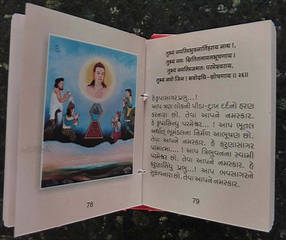
Pages of a modern Bhaktāmara-stotra
Image by Nalini Balbir © Nalini Balbir
The popularity of the Bhaktāmara-stotra is evidenced by numerous commentaries in Sanskrit and vernacular languages, and by many poetic or prose translations. Contemporary Jains may know it in either Sanskrit or modern languages.
Scholar-monks wrote commentaries on the hymn probably soon after its composition, with the earliest surviving commentary dating from the 14th century. Commentaries are still being produced on this widespread song of devotion.
Examples of significant commentaries in Sanskrit on the hymn are in the table.
|
Author |
Date |
Details |
|---|---|---|
|
Guṇākara |
Written by a Śvetāmbara monk, who was a pupil of Guṇacandra-sūri of the Rudrapallīya-gaccha. |
|
|
Kanakakuśala |
1595 CE (1652 VS) |
Produced by a Śvetāmbara monk, who was a pupil of Hīravijaya-sūri of the Tapā-gaccha. |
|
Meghavijaya-gaṇi |
17th century |
Written by a Śvetāmbara monk, who was a pupil of Vijayaprabha-sūri of the Tapā-gaccha. |
Surviving translations of the Bhaktāmara-stotra into vernacular languages date back to the 17th century. Translations are still being undertaken in modern times. Recent translations may be recorded and circulated on modern audio technology. Contemporary Jains may prefer these for their devotions to the original Sanskrit text.
The table gives details of some important vernacular language translations of the hymn.
|
Author |
Date |
Language |
Details |
|---|---|---|---|
|
Muni Devavijayaji |
1673 |
Old Hindi |
‘Devavijayaji has used different forms of melodies or rāga in composing the different poems. When these are sung by groups of singers with appropriate accompanying instruments it creates an atmosphere of joy and serenity’ (Kapashi 2007: 91) |
|
Hemaraj Pande |
Hindi |
|
|
|
Nathuram Premi |
|
|
|
|
Mavji Damiji Shah |
|
Translation using a metre different from the original, with one stanza translation for each original verse (Pandit and Shah 1999: 428–436). |
There are also many modern presentations of the contents of the hymn, which may show sectarian orientations. There are also several contemporary imitations of the poem that reuse certain phrases (see examples in Cort 2006: 102).
Stories
Hymns can be recited or sung out of pure devotion. But Jains also chant or sing them to gain various benefits. Several stanzas of the Bhaktāmara-stotra emphasise the quasi-miraculous power of reciting the Jina’s name, once it is designated as a mantra, as in verses 42 or 46. It can remove all types of fears and cure various diseases. Further, the hymn’s impact – prabhāva – or its greatness – mahiman – is made clear in stories of various characters whose experiences shows how they were protected by the hymn. A similar pattern can be found for another fundamental Jain hymn, the Pañca-namaskāra-mantra.
Such stories are found in the commentaries. The main source is Guṇākara’s commentary, which has 28 tales. Each story is associated with a specific verse, and points to its efficacy in particular circumstances. Thus each verse is put in context, and made alive through a gallery of word-portraits from various times and places (see Kapashi 2007: 105–112).
After reciting one or several verses of the hymn, the figures in the tales are rescued from difficult or perilous situations. The wicked people who had caused them torment or endangered them are also punished. It is impossible for a Jina to intervene in human activities in such contexts, as he is liberated from worldly affairs, so his female attendant – yakṣī – acts instead. The yakṣī Cakreśvarī is thus a recurring character in the stories. As the intermediary between the human being and the Jina, she decides to grant protection to the hymn’s chanter.
The table summarises the situations in which chanting the Bhaktāmara-stotra results in the reciter’s rescue or gain.
|
Verse number |
Story number |
Summary |
|---|---|---|
|
1 to 2 |
1 |
A king puts a merchant down a deep well. |
|
3 to 4 |
2 |
A poor merchant is caught in a storm while on a boat. A monk tells him to recite verses 3 and 4 of the hymn. He is saved with the help of Cakreśvarī and becomes rich (see pages 427 to 428 of Lefeber 1995 for translation). |
|
7 |
3 |
The houses of two Jain merchants become totally dark, covered with dust by a yogi who is infuriated that they did not come to worship him. |
|
8 to 9 |
4 |
A poor man, named Keśava, is attacked by a lion in the jungle, then tricked by a stranger, who puts him down a well. |
|
11 |
5 |
A poor merchant meditates on this verse and finds his life changed. |
|
12 |
6 |
The Jina’s superiority over various Hindu gods is demonstrated through this story |
|
13 to 14 |
7 |
A young woman refuses to eat at her wedding-feast before she has recited the hymn. She chants it that night and receives magic garlands. |
|
15 |
8 |
A wicked yogi paralyses King Sajjana’s body and no cure can be found. A Jain teacher is asked for help. While Jain monks meditate on stanza 15, a deity anoints the feet of one of them with water, which thus becomes holy. Following the Jain teacher’s advice, this monk is brought before the king and the water from his feet cures the king. |
|
16 to 17 |
9 |
A father finds the way to teach his non-believer son. |
|
18 |
10 |
A minister is saved in the jungle and also receives various boons. |
|
19 |
11 |
Learning the hymn leads to the gaining of a magic gem. |
|
20 |
12 |
After meditating through the night on the 20th verse of the hymn, the monk Vijayasena-sūri receives from the goddess Cakreśvarī the ability to answer all questions. |
|
21 |
13 |
A Jain monk had acquired supernatural powers through regular recitations of this verse. When he is in an area where everybody had converted to other religions, he shows the people the Hindu gods, including Śiva, bowing down to the Jina (see a full translation on pages 429 to 430 in Lefeber 1995). |
|
22 |
14 |
A Jain monk liberates people from a troubling yakṣa, a Buddhist teacher reborn. |
|
23 |
15 |
After the same Jain monk meditates on verse 23 of the hymn, the goddess Cakreśvarī grants him the ability to overpower wicked gods. As a consequence, he is able to transform an enraged, wicked goddess representing false doctrine into a peaceful one who bows down to him (see full translation on page 430 to 431 in Lefeber 1995). |
|
25 |
16 |
These verses are said to include an important mantra. |
|
26 |
17 |
A merchant who had many troubles learns the verse ‘Praise to you’ from a monk. He chants it and the goddess of prosperity makes him wealthy (Cort 2006: 99–101). |
|
27 |
18 |
King Sātavāhana has everything to be happy, except for a son. He tries everything to get one, but in vain. |
|
31 |
19 |
Gopāla is a good-natured man but poor. A Jain monk advises him to meditate on the hymn. One night, he dreams of the first Jina with the royal symbol of the three parasols. The next day he instals a Jina image that has appeared from the ground and chants the hymn in front of it. Gopāla meditates and has amazing dreams for six months. |
|
33 |
20 |
A very poor man meets a Jain monk who teaches him the doctrine and gives him an image of Lord Pārśva. He starts worshipping it regularly. While he is meditating on the 33rd verse of the hymn, a celestial palace appears before him and Cakreśvarī descends from it. Happy with the man’s devotion, she offers him a jewel. She places it on his arm, where it will help him have power over everything, and disappears. |
|
34 |
21 |
Prince Somarāja has lost his position and home, so is forced to wander. He meets a Jain monk, who teaches him the doctrine. He recites the hymn. |
|
35 |
22 |
Devarāja, a pious but poor Jain, recites the hymn and practises religion as his religious teacher has taught him. He takes a job travelling with a merchant’s caravan. They wander through the jungle and halt for a break. Devarāja takes a bath and begins chanting the hymn. |
|
36 |
23 |
A businessman is saved from a forest fire. |
|
37 |
24 |
Suspecting her husband of planning to kill her, a devout lady recites the hymn. Then she finds that the snake he has hidden in a pot changes into a garland of flowers. |
|
39 |
25 |
Fearing that his younger brother Guṇavarman wants to take his place, the king banishes him. Living in the forest, as it is the rainy season, Guṇavarman recites the hymn. While he is meditating in particular on verse 39, Cakreśvarī appears and asks him which favour he would like. She gives him the favour of a kingdom, and disappears. |
|
40 |
26 |
Dhanāvaha is a good merchant who has heard the teaching of a Jain monk and puts it into practice, especially the vow of non-violence. He also recites the hymn. |
|
41 |
27 |
Prince Rājahaṃsa is afflicted with terrible diseases. He meditates upon the hymn, in particular on verse 41. This satisfies the goddess Cakreśvarī, who cures him completely. |
|
42 |
28 |
A Jain lay man is arrested and imprisoned after false accusations, but is miraculously released as a reward after meditating on verse 42 of the hymn (see full translation in Lefeber 1995: 432–433). |
Besides those found in Guṇākara’s commentary, stories from other sources are also known. See a telling of the story of the poor carpenter Devala, whose attention was caught by the hymn’s fifth verse. Another one relates to verse 18.
Contemporary Jains are usually very familiar with the stories that make the Bhaktāmara-stotra such a central song of devotion.
Recitation and worship
The Bhaktāmara-stotra is one of the hymns most widely found in worship and ritual. It is used in private or communal acts of worship and is also the focus of a dedicated rite – Bhaktāmara-pūjā.
Most Jain houses have a copy of the Bhaktāmara-stotra. The text is available in many forms as there is an infinite number of popular editions. In particular, this hymn can be read in miniature books no larger than 5 by 7 centimetres, which may have the Sanskrit text, a translation in Gujarati or Hindi and some illustrations. Its popularity is further evidenced by the availability of a fairly large number of manuscript copies in Jain manuscript libraries.
The most common way of using the Bhaktāmara-stotra is for a Jain to read or recite it at home. It seems unanimously accepted that the most appropriate time is the early morning. Worshippers are recommended to face the east or the north during recitation. Mendicants also chant or recite this hymn, which is at the centre of Jain ‘devotional culture’ (Cort 2006).
In addition, the hymn itself is the object of ceremonial worship – Bhaktāmara-pūjā. There are other famous hymns that are similarly the centre of worship, but not many. Examples include the:
- Namaskāra-mantra
- Uvassagahara-stotra
- Santikara-stotra
- Kalyāṇamandira-stotra.
Nowadays collective worship ceremonies are increasingly organised and provide occasions for people to gather for religious and social purposes. They take place in India but also among the Jain diaspora communities in the UK and USA. Examples in London reported on the HereNow4U website include:
- 24 hours spent chanting the Bhaktāmara-stotra for the Akṣaya-tr̥tīyā festival on 20th April 2007
- the Bhaktāmara-stotra-pūjā during the 2006 festival of Paryuṣaṇ.
Mantras and yantras
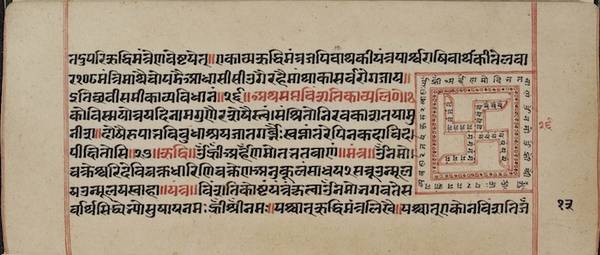
Auspicious yantra
Image by British Library © CC0 1.0 (Creative Commons Public Domain)
A full performance of worship involving the Bhaktāmara-stotra implies reciting the verses but also chanting the mantras and contemplating the accompanying drawings of mystical diagrams – yantras. Both these elements have developed in association with the Bhaktāmara-stotra. Each verse has come to have its own mantra and yantra, as manuscripts show.
One manuscript of the 44-verse version of the hymn on JAINpedia, under the British Library shelfmark Or. 13741, is a good representative of this trend. Each of the verses has the:
- original Sanskrit verse, called ‘poem’ – kāvya
- corresponding mantra
- procedure to draw the corresponding diagram, all of different forms
- diagram itself, filled with the syllables of the mantra.
Such manuscripts are also widely known among the sect of the Digambaras. The website of the International Digamber Jain Organization provides digital versions of examples held in India, such as this lavishly illustrated manuscript and this colourful manuscript.
This tradition is continued in modern handbooks on the ritual of Bhaktāmara worship (Pandit and Shah 1999). Comparisons of the mantras and yantras in various sources suggest that there are traditional associations, though it is not set in stone. The same mantras and similar yantras are used for a given verse, but several variants are found.
On the other hand, independent yantras relating to this hymn are also available.
Bhaktāmara ceremony
Among all sects the full Bhaktāmara ritual takes place only on certain occasions. These include (Cort 2006: 107) the:
- completion of lengthy fasts
- promotion of monks
- lay women renouncing the world to become nuns
- anniversary of the death of a monk or lay woman
- anniversary of an image consecration.
In a complete Bhaktāmara worship rite – Bhaktāmara-pūjā – several components of worship play a role, as shown in the photographs and report on the Herenow4U website. Here are the stages of a Śvetāmbara pūjā carried out in London in 2005, as reported in Kapashi 2007 (pages 153 to 155).
First, the area for worship is cleared and washed with milky water, which is regarded as holy. A Jina image is placed in the middle of a three-tiered platform. The initial stage is the bathing and anointing of the Jina figure – snātra-pūjā. This is a re-enactment of the lustration or bathing ceremony at a Jina’s birth.
Then preliminary mantras are recited. These mantras may be recited on any occasion and are not reserved for this ceremony.
Next a diagram of the rāyaṇa tree, which is associated with the first Jina’s omniscience, is drawn on the floor. Six small shrines are also drawn, dedicated respectively to:
- the gods who are the guardians of the directions – kṣetra-pālas
- Gomukha, who is R̥ṣabha’s yakṣa
- Cakreśvarī, who is his yakṣī
- Mānatuṅga-sūri, the author of the hymn
- the footprints of the first Jina
- the footprints of a teacher.
Then 44 yantras, one per stanza, are drawn and kept ready.
Next, the Sanskrit verses for remembering the Jina, the yakṣa, the yakṣī and the poet are recited.
Then worship of each stanza is conducted in the following way:
The first verse is recited and an offering (sweet, betelnut, etc.,) is made. At the same time yantra No. 1 is worshipped and anointed. A priest [pujārī] loudly recites the mantra for worship and after that one person strikes a stick twenty seven times on the bronze plate or thālī. This is somewhat like ringing a bell and is done rhythmically with a pleasant sound. Then a lighted lamp dīpaka is placed around the tree, which has been drawn on the floor. The worship of the first verse is thus completed. The same procedure is followed for the remaining verses
Kapashi 2007: 155
Finally, the ritual of completion is carried out with holy milky water, which is poured into a bronze vessel. People put a few drops on their heads, or carry some home to be given to their relatives.
During the worship rite, the officiating priest may recount stories demonstrating the powers of the hymn. The whole event ends with a community meal. The whole ritual is usually said to last up to two days, but is nowadays achieved in six hours (Kapashi 2007: 155).
There are variants of this general scenario, as Cort’s description of the ritual (2006: 107–109) shows.
Illustrations
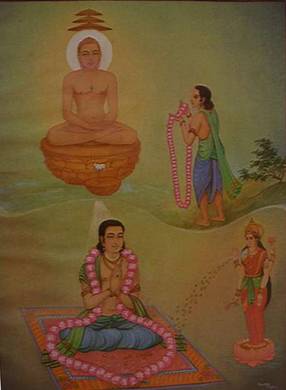
Final verse of the Bhaktāmara-stotra
Image by Diwakar Prakashan / Padma Prakashan © Diwakar Prakashan / Padma Prakashan
Traditional manuscripts and modern publications of the Bhaktāmara-stotra use paintings and drawings quite often. In addition to the yantras that usually accompany the text, painted scenes may illustrate the text. Like the yantras, such depictions may help worshippers focus on their prayer and avoid distractions.
There are a few Digambara manuscripts of the Bhaktāmara-stotra where the verses are illustrated by figurative paintings and scenes. They do not depict the stories from the commentaries, but the text of the verses. Thus abstract concepts are translated into pictures (Granoff 2010). The picture is divided into several elements, which are accompanied by words from the text as captions. The pages look rather like or are presented like those of comic books. These paintings are thus reworkings of the words of text in a different medium.
These manuscripts show features characteristic of Digambara paintings, such as the:
- depiction of Mānatuṅga as a full-fledged, naked Digambara monk
- Jina shown fully naked and devoid of any ornament or anything else.
In modern popular editions produced among Śvetāmbaras, similar paintings are found, but Mānatuṅga is depicted as a Śvetāmbara monk.
A devotee finds the presence of such paintings effective.
There are many means of attaining deep concentration in chanting a devotional song. The simplest available means is looking at an illustration. In the illustration the form of our Lord and the sentiments of the devotee appear to take tangible shape. The visual depiction of the meaning of the words we recite, when seen in the illustration, makes us understand the essence effortlessly, and that visual imagery is absorbed by the mind. As such, looking at the illustration[,] besides simplifying the meaning of the words, helps [with] achieving concentration. The problem of distraction from meditation and devotion is automatically solved. It is my personal experience that[,] while reading the couplets[,] when I look at the illustrations there appears a stability in the thoughts, a harmony in feelings and an unprecedented and undescribable emotional involvement. There rises a feeling of proximity with the Lord. Even while looking away from the scene, the image lingers on for some time. The memory of pure feelings and images keep the mind engrossed in devotion
Illustrated Bhaktamar Stotra, Preface, page 7
Temples
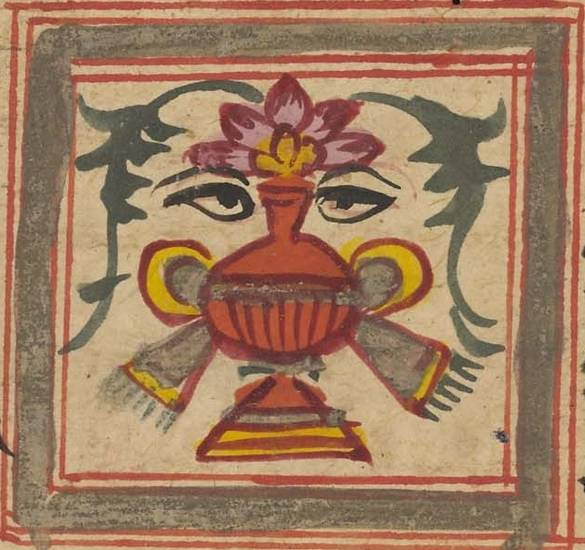
Symbol of the full jar
Image by British Library © CC0 1.0 (Creative Commons Public Domain)
Given the value attached to this hymn, its popularity and pre-eminence in ritual and worship, it is not surprising that there are a few temples where the Bhaktāmara-stotra is given prominence. The text is usually inscribed either in full or in part on temple walls.
These are relatively modern developments, parallel to the ever-increasing devotion to this hymn. The hymn has become the centre of religious culture because of the way it describes the Jina and the power ascribed to its verses.
Although he does not go into detail, Kapashi (2007: 76) states that:
there are at least three beautiful temples in India totally devoted to this stotra. In each temple all the verses of this stotra with their yantras have been carved in marble, and the statues of the first Tīrthaṅkara R̥ṣabhadeva, as well as the poet of this stotra have been erected in these temples[.]
Instances of temples that feature the Bhaktāmara-stotra are given in the table.
|
Name |
Location |
Information |
|---|---|---|
|
Shri Bhaktamar Bhavya Mandir |
Bharuch in Gujarat |
A Śvetāmbara temple dedicated to the hymn and the first Jina. It features: |
|
|
Santhu, Jalore district of Marwar, in Rajasthan |
The Bhaktāmara-stotra is inscribed in golden letters on the walls of the temple |
|
Naya Mandir |
Dharampura area of Delhi |
A Digambara temple housing an image of the first Jina with nine stanzas inscribed above. |
|
Sanghiji temple |
Sanganer, near Jaipur in Rajasthan |
An elaborately carved Digambara temple dedicated to the first Jina, which has a panel illustrating each verse of the Bhaktāmara-stotra. |
Other such temples are in:
- Pune, Maharashtra
- Sammet Shikhar, Bihar
- Sankheshwar, in Gujarat.
See page 110 of Cort 2006 for more information.
Reading
- Bhaktāmara, Kalyāṇamandira and Namiuṇa
Mānatuṅga and Siddhasena Divākara - edited by Hermann Jacobi
Sheth Devchand Lalbhai Jain Pustakoddhar Fund series; volume 79
J. S. Javeri; Surat, Gujarat, India; 1932
- Bhaktāmara-stotra
Mānatuṅga - translated by Amṛtlāl Śāstrī
Varanasi, Uttar Pradesh, India; 1969
- Illustrated Bhaktamar-Stotra
Mānatuṅga - edited by Shricand Surana ‘Saras’
Diwakar Prakashan and Prakrit Bharati Academy; Agra, Uttar Pradesh and Jaipur, Rajasthan, India; 2006
- Bhaktamara Stotra
Mānatuṅga - translated by Nathuram Premi and Manish Modi
Pandit Nathuram Premi Research series; volume 37
Hindi Granth Karyalay; Mumbai, Maharashtra, India; 2012
- Mānatuṅgācārya aura unake stotra
Madhusudan A. Dhaky and Jitendra B. Shah - Sri Svetambara Murtipujaka Jaina Bordinga granthamala series; volume 13
Sharadaben Chimanbhai Educational Research Center; Ahmedabad, Gujarat, India; 1997
- ‘Cures and Karma: Attitudes Towards Healing in Medieval Jainism’
Phyllis Granoff - Self, Soul and Body in Religious Experience
edited by A. l. Baumgarten with J. Assmann and G. G. Stroumsa
Numen Book series; volume 78
Brill; Leiden, Netherlands; 1998
- ‘Illustrating the Bhaktāmarastotra’
Phyllis Granoff - Svasti – essays in honour of Prof. Hampa Nagarajaiah for his 75th Birthday
edited by Nalini Balbir
Muddushree Granthamala series; volume 75
K. S. Muddappa Smaraka Trust; Bangalore, Karnataka, India; 2010
- ‘Zwei Jaina-stotra’
Hermann Jacobi - Indische Studien
volume 14
Deutsche Morgenländische Gesellschaft; Berlin and Leipzig, Germany; 1876
- Nava Smaraṇa: Nine Sacred Recitations of Jainism
Vinod Kapashi - edited by Signe Kirde
Hindi Granth Karyalay; Mumbai, Maharashtra, India; 2007
- Bhaktāmara-rahasya
Śatāvadhānī Paṇḍit and Śrī Dhīrajalāla Śāh - Navabhārata Sāhitya Mandira; Ahmedabad, Gujarat, India; 1999
Links
- Bhaktāmara-stotra – Digambara
-
YouTube provides a video of the original Sanskrit Bhaktāmara-stotra, accompanied by pictures of Jina figures. The Digambara version of 48 stanzas is sung by the Rajasthani classical singer Rattan Mohan Sharma.
- Bhaktāmara-stotra – Digambara text
-
The 48 Sanskrit verses of the Digambara version of the hymn are presented in Nagari and transliteration with English translation below, on a faculty private page on the Colorado State University website. The hymn is considered to be a masterpiece of Sanskrit poetry.
- Bhaktāmara-stotra – Śvetāmbara recitation
-
The original Sanskrit Bhaktāmara-stotra is recited by the Śvetāmbara monk Param Pujya Vijay Bhuwan Shekhar Surishwarji Maharaj. This 2010 YouTube video contains pages of an illustrated publication of the hymn, which is a masterpiece of Sanskrit poetry.
- Bhaktāmara-stotra – Śvetāmbara text
-
The HereNow4U website provides the Sanskrit text of the Śvetāmbara hymn in Nagari, English translation and word-to-word translation, accompanied by modern illustrations. There is also a glossary of Sanskrit terms.
To move to another verse, click on one of the arrows above the title or slide the button along the scroll bar.
- R̥ṣabha and Indra
-
A manuscript painting in the Los Angeles County Museum of Art shows Indra, king of the gods, taking the infant R̥ṣabhanātha or Lord R̥ṣabha, the first Jina, to Mount Meru for his ritual bath. The decorated elephant and canopy symbolise royalty while the lotus flowers are emblems of spiritual purity. The gods around blow trumpets and conches in celebration. A very popular Jain hymn of praise, the Bhaktāmara-stotra has been translated into many languages and illustrated numerous times.
- Mānatuṅga and the Bhaktāmara-stotra
-
HereNow4U provides a version of the tale of Mānatuṅga, composer of the very popular Bhaktāmara-stotra hymn. The Digambara story found here recounts how the power of the hymn frees Mānatuṅga from his chains.
- King puts a merchant down a well
-
JainSquare.com provides a story associated with the Bhaktāmara-stotra hymn. This tale, found in Guṇākara's famous 14th-century commentary, is associated with the first two verses of the hymn. Unfortunately, the level of English makes it difficult to understand in places.
https://jainsquare.wordpress.com/?s=Blessings+from+The+Goddess
- King Hemabrahma and Queen Hamesri
-
JainSquare.com provides a story associated with the Bhaktāmara-stotra hymn. This tale of King Hemabrahma and Queen Hamesri is associated with the ninth verse of the hymn. Unfortunately, the level of English makes it difficult to understand in places.
- Bhaktāmara-stotra – illustrated pages
-
The University of Michigan Museum of Art holds pages of a Digambara manuscript which Phyllis Granoff of Yale has identified as illustrated pages of a Digambara Bhaktāmara-stotra. Her 2010 article, 'Illustrating the Bhaktāmarastotra', can be seen on the HereNow4U website.
http://quod.lib.umich.edu/cgi/i/image/image-idx?type=bbaglist;view=bbthumbnail;bbdbid=796751910
- Bhaktāmara-stotra worship ritual
-
During the 2006 festival of Paryuṣaṇ, Jains take part in the rite of Bhaktāmara-stotra pūjā in London. This report from the HereNow4U website provides a first-hand account and pictures of the ceremony. The Bhaktāmara-stotra is one of the few Jain hymns to be the focus of ceremonial worship.
- Bhaktāmara-stotra ceremony
-
A first-hand illustrated report on the Bhaktāmara-pūjā or worship ritual, held in London in 2005, is provided on the HereNow4U website. The report and photographs show some stages of the Digambara ceremony, which is celebrated by the whole community. The Bhaktāmara-stotra is one of the few Jain hymns to be the centre of religious worship.
- Chanting the Bhaktāmara-stotra
-
On 20th April 2007 Jains in London spent 24 hours reciting the Bhaktāmara-stotra for the Akṣaya-tr̥tīyā festival. The hymn is one of the best-known Jain devotional songs and, like the Akṣaya-tr̥tīyā festival, is associated with Ṛṣabhanātha or Lord Ṛṣabha, the first Jina. This illustrated report by Hina Vora is on the HereNow4U website.
- Namaskāra-mantra and Bhaktāmara-stotra with yantras – part one
-
This YouTube slideshow features a recording of the Namaskāra-mantra followed by the Bhaktāmara-stotra, a famous Sanskrit hymn of praise to the first Jina, Ṛṣabha.;
Also known as the Navkār-mantra or Namokār-mantra, the Namaskāra-mantra is a very old mantra in Prakrit. It can be sung to different tunes and is chanted daily to honour the 'five types of beings worthy of worship' or Supreme Beings':
Bhaktāmara-stotra means Devoted Gods. This title comes from the first verse, which describes how all the gods offer homage to Ṛṣabha. The slideshow includes colour-tinted yantras and mantras to help listeners meditate.
This is the first of four parts of the Śvetāmbara hymn, which has 44 verses. This part contains stanzas 1 to 12.
http://www.youtube.com/watch?v=ZzJtiikKnh4
This YouTube slideshow features a recording of the Bhaktāmara-stotra, a famous Sanskrit hymn of praise to the first Jina, Ṛṣabha. The title Devoted Gods comes from the first verse, which describes how all the gods offer homage to Ṛṣabha. The slideshow includes colour-tinted yantras and mantras to help listeners meditate.
This is the first of four parts of the 44-verse Śvetāmbara hymn, covering stanzas 01 to 12
https://www.youtube.com/watch?v=ZzJtiikKnh4&list=PLE8A9751AC19A4277
- Bhaktāmara-stotra with yantras – part two
-
This YouTube slideshow features a recording of the Bhaktāmara-stotra, a famous Sanskrit hymn of praise to the first Jina, Ṛṣabha. The title Devoted Gods comes from the first verse, which describes how all the gods offer homage to Ṛṣabha. The slideshow includes colour-tinted yantras and mantras to help listeners meditate.
This is the second of four parts of the 44-verse Śvetāmbara hymn, covering stanzas 13 to 25.
- Bhaktāmara-stotra with yantras – part three
-
This YouTube slideshow features a recording of the Bhaktāmara-stotra, a famous Sanskrit hymn of praise to the first Jina, Ṛṣabha. The title Devoted Gods comes from the first verse, which describes how all the gods offer homage to Ṛṣabha. The slideshow includes colour-tinted yantras and mantras to help listeners meditate. The yantras in this part begin with the svastika, ancient Asian symbol of well-being and good fortune.
This is the third of four parts of the 44-verse Śvetāmbara hymn, covering stanzas 26 to 38.
- Bhaktāmara-stotra with yantras – part four
-
This YouTube slideshow features a recording of the Bhaktāmara-stotra, a famous Sanskrit hymn of praise to the first Jina, Ṛṣabha. The title Devoted Gods comes from the first verse, which describes how all the gods offer homage to Ṛṣabha. The slideshow includes colour-tinted yantras and mantras to help listeners meditate.
This is the last of four parts of the 44-verse Śvetāmbara hymn, covering stanzas 39 to 44.
- Bhaktamar Mahayantra
-
A 'great yantra' honouring the Bhaktāmara-stotra on the HereNow4U website. A very popular Jain hymn of praise, the Bhaktāmara-stotra is closely associated with mantras – auspicious syllables – and mystical diagrams – yantras. Reciting the mantras and meditating on the yantras is part of the Bhaktāmara-stotra worship ceremony. Each verse has developed its own mantra and yantra, but there are also yantras designed to be contemplated when chanting the whole hymn.
- Bhaktāmara temple
-
The Jinalaya website provides information about the Shri Bhaktamar Bhavya Mandir in Baruch, Gujarat. The temple is dedicated to the first Jina, Ṛṣabha, and the devotional song of the Bhaktāmara-stotra. The temple houses an image of the hymn's composer, Mānatuṅga, and the 44 stanzas of the Śvetāmbara version, as well as figures of the first Jina.
- Harsukhrai Temple
-
The HereNow4U website reprints a 1945 article on the Harsukhrai Temple at Dharmapura, Delhi, also called the Naya Mandir. The article describes and provides photographs of the Digambara temple, which features verses of the Bhaktāmara-stotra. The famous hymn of the Bhaktāmara-stotra is associated with miraculous powers that come from repeating its verses, especially the name of the first Jina, Ṛṣabha.
- +
- aAbhavya
- aAbhinandana
- aAbhiṣeka
- aĀcāra
- aĀcārāṅga-sūtra
- aĀcārya
- aAchalbhrata
- aAḍhāī-dvīpa
- aAdharma
- aAdho-loka
- aAdhyayana
- aAdvaita Vedānta
- aĀgama
- aAghātīya
- aAghātīya-karman
- aAgnibhuti
- aAgra
- aĀhāra
- aAhiṃsā
- aAhimsa Day
- aAjita
- aAjīva
- aAkampit
- aĀkāśa
- aAkbar the Great
- aAkṣaya-tṛtīyā
- aAlauddin Khalji
- aAlbert Einstein
- aAllah
- aAlms
- aĀlocanā
- aAloka-ākāśa
- aAmāri
- aAmbikā or Kūṣmāṇḍinī
- aAnagāra
- aAnanta
- aAnarthadaṇḍa
- aAnaśana
- aAnekānta-vāda
- aAṅga
- aAniconism
- aAnojjā
- aAntarāla
- aAntarāya-karma
- aAṇu
- aAṇu-vrata
- aAnukampā
- aAnuprekṣā
- aAnusvāra
- aApabhraṃśa
- aAparigraha
- aAra
- aĀrambha
- aĀrambhaja
- aĀratī
- aArdhamāgadhī Prākrit
- aArhaṃ
- aArhat
- aArśana-āvaraṇīya-karma
- aĀrta-dhyāna
- aĀryikā
- aĀryikā Jñānamati
- aĀśātanā
- aĀścarya
- aAscetic
- aAsceticism
- aAshram
- aAspiration
- aĀsrava
- aAṣṭa-maṅgala
- aAṣṭāpada
- aAstikāya
- aAstrolabe
- aAsura
- aAtheism
- aAticāra
- aAtiśayakṣetra
- aAtithisaṃvibhāgavrata
- aĀtma-vāda
- aĀtman
- aAuṃ
- aAurangzeb
- aAuspicious
- aAusterity
- aAvadhāna
- aAvadhi-jñāna
- aĀvaraṇī-yakarman
- aAvasarpiṇī
- aAvatāra
- aAvidyā
- aAxiom
- aĀyāga-paṭa
- aĀyambil
- aĀyu-karma
- aĀyurveda
- bBabur
- bBāhubali
- bBaladeva
- bBālāvabodha
- bBandha
- bBasadi
- bBazaar
- bBhadrankarvijay
- bBhagavant
- bBhaktāmara-stotra
- bBhakti
- bBhale
- bBharata
- bBhāṣā
- bBhāṣya
- bBhaṭṭāraka
- bBhāva
- bBhāva-pūjā
- bBhāvanā
- bBhavana-vāsin
- bBhavya
- bBhavyatva
- bBhaya
- bBhoga-bhūmi
- bBhogopabhoga
- bBodhi
- bBollywood
- bBrahmā
- bBrahma-deva
- bBrahmacārī
- bBrāhmaṇa
- bBraj Bhāṣā
- bBright fortnight
- bBritish Raj
- bBuddha
- bBuddhi-sagar
- bBuddhism
- bBuddhist
- cCaitya
- cCaityavāsin
- cCakravartin
- cCakreśvarī
- cCāmara
- cCandanā
- cCandragupta
- cCandraprabha
- cCanon
- cCāritra
- cCāritramohanīya-karman
- cCarũrī
- cCaste
- cCaturvidha-saṅgha
- cCaturviṃśati-stava
- cCāturyāma
- cCE
- cCelibacy
- cCha
- cChadmastha
- cChastity
- cCheda-sūtra
- cChristian
- cChristianity
- cClergy
- cCloning
- cColophon
- cCommentary
- cConch
- cConfession
- cCongregation
- cConsecration
- cCosmology
- cCremation
- cCrore
- cCult
- cCūrṇi
- dDādā-guru
- dDalit
- dDāna
- dDaṇḍa
- dDark fortnight
- dDarśana
- dDarśanamohanī-yakarman
- dDaśa-lakṣaṇa-parvan
- dDeity
- dDelhi Sultanate
- dDerāsar
- dDeśāvakāśika-vrata
- dDetachment
- dDevanāgarī
- dDevānandā
- dDevarddhi-gani
- dDevotee
- dDhamal
- dDhanuṣ
- dDhāra
- dDharma
- dDharma-dhyāna
- dDharma-sāgara
- dDharmastikaya
- dDhātakīkhaṇḍa
- dDholak
- dDhyāna
- dDiaspora
- dDig-vrata
- dDigambara
- dDīkṣā
- dDisciple
- dDīvālī
- dDivya-dhvani
- dDNA
- dDoctrine
- dDogma
- dDonor
- dDoṣa
- dDravya
- dDravya-pūjā
- dDrone
- dDuṣamā
- dDuṣamā-duṣamā
- dDuṣamā-suṣamā
- dDveṣa
- dDvīpa
- eEast India Company
- eEightfold Path
- eEkānta-vāda
- eEkendriya
- eElder
- eElders
- eEschatology
- eEtc up to
- fFarmān
- fFast
- fFatehpur Sikri
- fFestival
- fFestschrift
- fFiruz Shah
- fFly-Whisks
- fFolio
- fFour Noble Truths
- gGaccha
- gGaṇa
- gGaṇadhara
- gGanadharavada
- gGaṇeśa
- gGaṇin
- gGarba
- gGarbha
- gGarbha-gṛha
- gGaruḍa
- gGati
- gGene
- gGenomics
- gGhātī-yakarman
- gGhātīya
- gGhaznavid
- gGhiyasuddin Tughlaq
- gGhurid
- gGloss
- gGotra-karma
- gGujarāt
- gGujarati
- gGuṇa
- gGuṇa-sthāna
- gGuṇa-vrata
- gGupti
- gGuru
- gGuruṇī
- hHagiography
- hHajj
- hHaṃsa
- hHaribhadra
- hHariṇaigameṣin
- hHasta
- hHeresy
- hHiṃsā
- hHindi
- hHindu
- hHinduism
- hHīravijaya
- hHoroscope
- hHrīṃ
- hHumayun
- hHymn
- iIconoclasm
- iIconography
- iIdol
- iIndian Independence
- iIndology
- iIndra
- iIndrabhūti Gautama
- iIndriya
- iInitiation
- iIntercession
- iInvocation
- iIQ
- iIslam
- iIslamicate
- iIṣṭadevatā
- iĪśvara
- jJagat
- jJahangir
- jJain
- jJaina Devanāgarī
- jJaina Śaurasenī
- jJaina-dharma
- jJainaśāsana
- jJainness
- jJaisalmer
- jJamāli
- jJambū-dvīpa
- jJames Burgess
- jJanma
- jJanma-kalyāṇa
- jJarā
- jJāti
- jJina
- jJina-āgama
- jJina-bhavana
- jJina-bimba
- jJina-mātā
- jJinacandra-sūri
- jJinadatta
- jJinaprabha
- jJīva
- jJñāna
- jJñāna-āvaraṇīya-karma
- jJñāna-āvarṇiya
- jJñānsundar
- jJyotiṣka
- kKāla
- kKālakācārya-kathā
- kKālidāsa
- kKalpa-sūtra
- kKalpa-vṛkṣa
- kKalyāṇaka
- kKalyanvijay
- kKamaṇḍalu
- kKamaṭha
- kKarma
- kKarma-bhūmi
- kKarma-grantha
- kKarma-prakṛti
- kKarma-vāda
- kKarmon
- kKarnataka
- kKaṣāya
- kKathā
- kKāvya
- kKāya
- kKāyotsarga
- kKeśa-loca
- kKetu
- kKevala-jñāna
- kKevalin
- kKhalji
- kKharatara-gaccha
- kKnowledge
- kKriyā
- kKriyā-vāda
- kKṛṣṇa
- kKṣamā-śramaṇa
- kKṣapakaśreṇi
- kKṣatriya
- kKṣullaka
- kKulakara
- kKundakunda
- kKunthu
- lLabdhi
- lLaity
- lLakh
- lLāñchana
- lLands of Action
- lLaukāntika
- lLavaṇa-samudra
- lLeśyā
- lLiṅga
- lLinguistics
- lLoka
- lLoka-ākāśa
- lLoka-puruṣa
- lLoka-vāda
- lLotus
- lLotus lake
- mMadhya-loka
- mMahā-videha
- mMahā-vrata
- mMahābhārata
- mMahāmastakābhiṣeka
- mMāhārāṣṭra
- mMāhārāṣṭrī Prākrit
- mMahattarā Yākinī
- mMahāvīr Jayantī
- mMahāvīra
- mMakāra
- mMakkhali Gośāla
- mMalli
- mMāna-stambha
- mManaḥ-paryāya-jñāna
- mMaṇḍala
- mMaṇḍapa
- mMandit
- mMaṅgala
- mMantra
- mMantras
- mManuṣya-loka
- mMarāṭhī
- mMārgaṇā
- mMartyr
- mMarudevī
- mMaṭha
- mMati-jñāna
- mMauryaputra
- mMecca
- mMendicant lineage
- mMetarya
- mMiracle
- mMithyādṛṣṭi
- mMohandas Gandhi
- mMohanīya-karma
- mMokṣa
- mMonastic order
- mMonasticism
- mMonk
- mMonotheism
- mMosque
- mMount Meru
- mMount Sammeta
- mMṛgāvatī
- mMughal
- mMuhammad
- mMuhammad bin Tughlaq
- mMuhpattī
- mMūla-sūtra
- mMūlaguṇa
- mMumbaī
- mMuni
- mMunisuvrata
- mMurad Bakhsh
- mMūrti-pūjaka
- mMuslim
- mMysticism
- nNābhi
- nNāga-kal
- nNāgapurīya Tapā-gaccha
- nNāgarī
- nNāma-karma
- nNamaskāra-mantra
- nNami
- nNandīśvara-dvīpa
- nNandivardhana
- nNandyāvarta
- nNāraka
- nNāraki
- nNasalisation
- nNātha
- nNavrātrī
- nNaya-vāda
- nNemi
- nNidāna
- nniggaṃthāṇa vā 2
- nniggaṃtho vā 2
- nNigoda
- nNihnava
- nNikṣepa
- nNirgrantha
- nNirjarā
- nNirvāṇa
- nNiryukti
- nNiṣidhi
- nNitya
- nNiyati
- nNo-kaṣāya
- nNudity
- nNun
- oOcean of milk
- oOmniscience
- oOrdination
- ppa°
- pPadmaprabha
- pPadmāsana
- pPadmāvatī
- pPādukā
- pPalanquin
- pPalette
- pPañca-muṣṭi
- pPāṇḍava
- pPaṇḍit
- pPandit Dalsukh D. Malvania
- pPandit Sukhlalji
- pPāṇipātra
- pPāpa
- pParamātman
- pParameṣṭhin
- pPāraṇā
- pParigraha
- pPariṇāma
- pParīṣaha
- pParokṣa
- pPārśva
- pPārśvanātha
- pParyāya
- pParyuṣaṇ
- pPaṭa
- pPatan
- pPātra
- pPenance
- pPersian
- pPhala
- pPhilology
- pPicchikā
- pPilgrimage
- pPīr
- pPolymath
- pPoṣadha
- pPossession
- pPothī
- pPrabhas
- pPradakṣiṇā
- pPradeśa
- pPrākāra
- pPrakīrṇaka-sūtra
- pPrākrit
- pPramāda
- pPramukhā
- pPrati-vāsudeva
- pPratikramaṇa
- pPratimā
- pPratiṣṭhā
- pPratyākhyāna
- pPratyakṣa
- pPravacana
- pPrāyaścitta
- pPrayer
- pPre-modern
- pPreach
- pPredestination
- pProtestant
- pProvenance
- pPudgala
- pPūjā
- pPujārī
- pPukharavara-dvīpa
- pPuṇya
- pPūrva
- pPuṣkara-dvīpa
- pPuṣpadanta
- pPyre
- qQur’an
- rRāga
- rRāhu
- rRainy season
- rRajasthan
- rRajasthani
- rRājimatī
- rRajoharaṇa
- rRajput
- rRāma
- rRāmāyaṇa
- rRangoli
- rRās-garbā
- rRasa
- rRathanemi
- rRatna-traya
- rRātri-bhojana
- rRaudra-dhyāna
- rRecto
- rRelic
- rRenunciation
- rRetroflex
- rRevatī
- %Ṛg-veda
- rRite
- rRosary
- %Ṛṣabha
- %Ṛṣabhanātha
- rRupee
- sSaciyā Mātā
- sSādhu
- sSādhvī
- sSāgāra
- sSaint
- sŚaivaism
- sŚaka-saṃvat
- sSallekhanā
- sŚalya
- sSamacatuṣṭha
- sSamādhimaraṇa
- sSamaṇi
- sSāmarambha
- sSamavasaraṇa
- sSāmāyika
- sSaṃbhava
- sSamiti
- sSaṃjñā
- sSaṃkalpaja
- sSaṃsāra
- sSamudghāta
- sSaṃvara
- sSaṃvega
- sSamyak-cāritra
- sSamyak-darśana
- sSamyak-jñāna
- sSamyaktva
- sSaṃyama
- sSanctuary
- sSandalwood
- sSaṇgha
- sSanskrit
- sSant
- sŚānti
- sSapta-bhaṅgi-naya
- sSārambha
- sSarasvatī
- sSarvajña
- sSāsan-devi
- sŚāsana-devatā
- sŚāstra
- %Ṣaṭ-jīvanikāya
- sSatī
- sSatīmātā
- sSatya
- sSchism
- sScribe
- sScripture
- sSect
- sSecularism
- sŚenāī
- sSermon
- sŚeṣavatī
- sSevā
- sSeven fields of donation
- sShah Jahan
- sShantidas Jhaveri
- sShrine
- sSiddha
- sSiddha-śilā
- sSiddhacakra or Navadevatā
- sSiddhānta
- sSiddhārtha
- sSiddhi
- sSikh
- sSikhism
- sŚikṣā-vrata
- sŚīla
- sSin
- sSindh
- sŚītala
- sŚiva
- sSkandha
- sSomanatha
- sŚraddhā
- sŚramaṇa
- sŚrāvaka
- sŚrāvakācāra
- sŚrāvikā
- sŚreyāṃsa
- sŚrī
- sŚrīvatsa
- sŚruta-jñāna
- sŚruta-pañcamī
- sSthānaka-vāsin
- sSthāpanācārya
- sSthāvara
- sSthavira
- sSthiti
- sStrīmukti
- sStūpa
- sSubcontinent
- sSudarshana
- sŚuddhi
- sSudharma
- sŚūdra
- sSufism
- sSukha
- sŚukla-dhyāna
- sSulasā
- sSultan
- sSumati
- sSundarśrī
- sSupārśva
- sSūri
- sSuṣamā
- sSuṣamā-duṣamā
- sSuṣamā-suṣamā
- sSūtra
- sSuyam me ausam! Tenam bhagavaya evamakkhayam
- sSvādhyāya
- sSvāhā
- sSvastika
- sŚvetāmbara
- sŚvetāmbara Terāpanthin
- sŚvetāmbaras
- sSwan
- sSyād-vāda
- tTabla
- tTantra
- tTapā-gaccha
- tTapas
- tTāraṇ Svāmī Panth
- tTattva
- tTattvārtha-sūtra
- tTemple
- tTemple-city
- tThe Enlightenment
- tTheology
- tThree worlds
- %Ṭīkā
- tTilaka
- tTīrtha
- tTīrthaṃkaranāma-karman
- tTīrthankara
- tTransliteration
- tTrasa
- tTrasa-nāḍī
- tTriśalā
- tTriṣaṣṭi-śalākā-puruṣa-caritra
- tTti bemi
- tTughlaq
- tTunk
- uUdumbara
- uUniversal History
- uUpādhyāya
- uUpāṅga
- uUpaniṣads
- uUpāsaka
- uUpasarga
- uUpāśraya
- uŪrdhva-loka
- uUtsarpiṇī
- uUttarādhyayana-sūtra
- vVāhana
- vVaimānika
- vVairāgya
- vVaiṣṇava
- vVaiśramaṇa
- vVaiśya
- vValabhī
- vVanaspatikāya
- vVandana
- vVaṇik
- vVarṇa
- vVāsudeva
- vVāsupūjya
- vVayubhūti
- vVeda
- vVedanīya-karma
- vVegetarianism
- vVehicle
- vVernacular
- vVerso
- vVidyā
- vVidyā-devī
- vVihāra
- vVijñapti-patra
- vVikrama-saṃvat
- vVikṛti
- vVimala
- vVinaya
- vVipāka
- vVirji Vora
- vVirodhaja
- vVīrya
- vVisarga
- vViṣṇu
- vVītarāga
- vVizier
- vVotive
- vVow
- vVrata
- vVS
- vVyakta
- vVyantara
- vVyasana
- yYakṣa
- yYakṣī
- yYantra
- yYaśoda
- yYaśovijaya
- yYati
- yYātrā
- yYoga
- yYoginī
- yYojana


